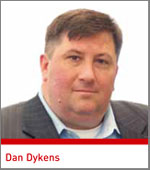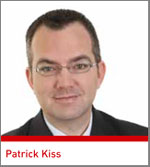Brad Allen talks to some pioneers of social media use for IR ends
A recent NIRI survey on measuring IR effectiveness revealed that most US IR professionals don’t count Twitter followers or Facebook friends to measure how effective their IR program is.
But there are some players aggressively adopting the new tools of social media and changing the landscape of investor relations. Here, IR magazine profiles four social media ‘top dogs’ and investigates the impact they are having on IR for everyone else.  Dan Dykens, co-founder and president, Meet the Street
Dan Dykens, co-founder and president, Meet the Street
Dykens spent a decade working his way up from trader and analyst to portfolio manager at four different long/short equity hedge funds. ‘I can’t tell you how many roadshow meetings I took where I had no intention of investing,’ he says. ‘My goal was purely to ferret out information about a competitor, the sector, or some such.
After seeing how many of my peers were doing the same, I realized there had to be a way for these executives to make more effective use of their valuable time.’
Before he got around to tackling corporate access, Dykens co-founded Norbury Financial Systems, a software firm that helps investment professionals manage information overload.
Dykens, recognizing that the internet was causing upheaval in ‘some very well-established business models’, combined his two experiences to take on corporate access incumbents ‘by enabling IROs – not the sell side, which can be quite conflicted – to drive the process.’
In 2007, he launched Meet the Street, a Facebook-like dating website for non-deal roadshows where issuers and investors find one another and decide to dance – or not – on their own time and terms without institutional sales analysts coming between them.
Both IROs and investors complete a profile that helps the software make a match. IROs have control over the invitation list of targeted investors in a particular city, and investors can flag companies they want to meet when they come through town.
The platform handles the invitations, the IRO builds the schedule and confirmations are sent out. The model must be working: in 2011, Meet the Street facilitated 245 meetings.
Issuers pay an annual fee of $7,500. Because the investors are billed $1,000 each for one-on-ones and $200 for group lunches, the buy side views it as a bargain.
Meet the Street, which is owned by Instinet, eliminates sell-side conflicts, gives IROs control and keeps interested investors informed when you’re coming through town.  Darrell Heaps, co-founder, president and CEO, Q4 Web Systems
Darrell Heaps, co-founder, president and CEO, Q4 Web Systems
Heaps is a prolific blogger and outspoken observer of all things IR online. Over the past five years at the helm of Q4 Web Systems, he has emerged as a true thought leader in the field, not just as an observer, but also as a provider of online IR communications and disclosure to hundreds of client companies across North America.
Prior to launching Q4 Web in 2006 with co-founder Chris Vickerson, Heaps served as CEO and president of another start-up, NKaos Interactive Media, one of Canada’s earliest web development and marketing companies, which did custom work for corporate and IR websites.
Heaps realized interaction between public companies and investors had the potential for dramatic change as the web evolved.
Today, the firm offers more than 30 scalable IR web modules, allowing an IRO to customize his or her corporate and IR web platform.
In addition, Q4 Web conducts research, issues white papers and reports, and provides webinars on IR website and social media best practices, which Heaps makes available on the company blog, Q4blog.com.  Andrea Wentscher, IR manager for retail investors, BASF
Andrea Wentscher, IR manager for retail investors, BASF
While Reg FD-wary US IROs have a reputation for taking a wait-and-see attitude to social media, the opposite is true at BASF, the global chemical giant based in Germany. ‘Online communication has always been very important to BASF,’ says Wentscher.
The chemical company’s global communications team took up the challenge of harnessing social media more than two years ago.
‘After a lot of reading and private experimenting’, Wentscher launched the BASF IR twitter feed (@BASF_IR) for the company’s Q3 earnings in 2009.
BASF averages nearly 26 tweets per month and tweeting is now ‘an established part of the communication mix at the company.’
Most tweets contain links to the company website, leading to press releases, updates on earnings estimates, new presentations and publications.
Even with that impressive volume, Wentscher says there is no fixed number of must-tweets during a week. ‘We tweet whenever there is something new,’ she emphasizes. ‘Quality before quantity!’
She adds that the strategy is focused on integrating BASF’s IR activities into the company’s broad communication mix, while targeting specific audiences.
She tweets all investor releases, which are also sent via traditional channels, and live-tweets during teleconferences, analyst meetings and other investor live events.
‘Twitter offers the possibility to highlight any new content right away,’ Wentscher observes. She also tweets to alert followers about new publications from the company, research papers, top management presentations, industry news and important organizational developments.
She tweets updates on analysts’ consensus when an estimate or ratings change is made, too – a tweet virtually guaranteed to raise blood pressure among US corporate counsel.
Wentscher says BASF eschews one-sided communications ‘whose sole objective is to send a message. Our aim is to enter into dialogue with our target groups about topics that are relevant for BASF.
‘We want to know how our work is being received by different stakeholders, especially the financial market. Social media are an excellent platform for achieving transparent and open dialogue with the public.’
While BASF is looking for a two-way dialogue, Wentscher admits the number of messages and questions is low, ‘corresponding to the number of requests we get from retail investors via traditional channels.’
Nonetheless, BASF finds the effort worthwhile. ‘The tonality of the feedback we get is absolutely positive,’ Wentscher concludes. Patrick Kiss, head of investor & public relations, Deutsche EuroShop
Patrick Kiss, head of investor & public relations, Deutsche EuroShop
Kiss is a frequent writer on IR issues and a gregarious online socializer, harnessing the web to bring together IR colleagues across Germany.
In 1999 he launched an online newsletter, Investor Relations DE, a German-language monthly compilation of IR news, book reviews and profiles.
It grew into an aggregation site for IROs with several different portals, including a jobs board, consultant listings, news articles and books of interest.
One of the more innovative features is a page where academic researchers can query IROs, enlisting practitioners’ participation in research projects.
In 2001 Kiss published Investor Relations im Internet [Investor relations on the internet], a German-language book examining the rise of online IR.
In May 2010 he launched a mostly English-language blog, IRrelevant, which he updates every few weeks. The blog allows Kiss to go into greater depth on news items and topics of interest to IROs.
In September 2011 he launched his newest venture, IRClub, a social media gathering site for German-speaking IROs.
‘IRClub is a little more interesting than my blog,’ Kiss says, adding that it inspires more re-tweets and grabs more traffic than IRrelevant.










